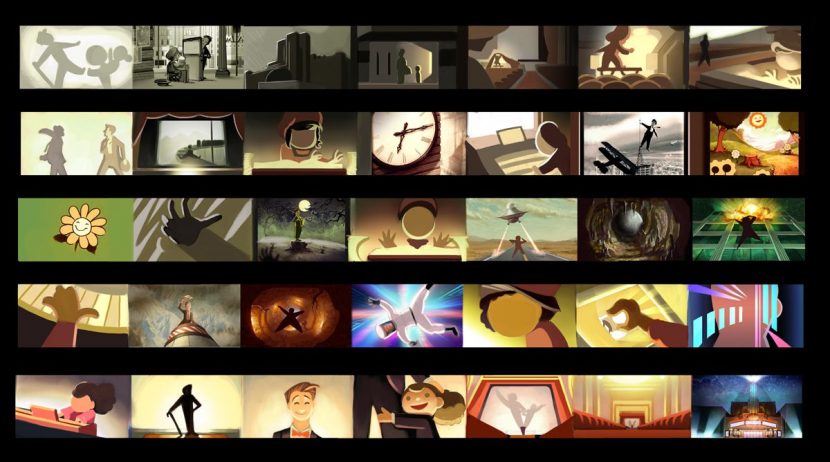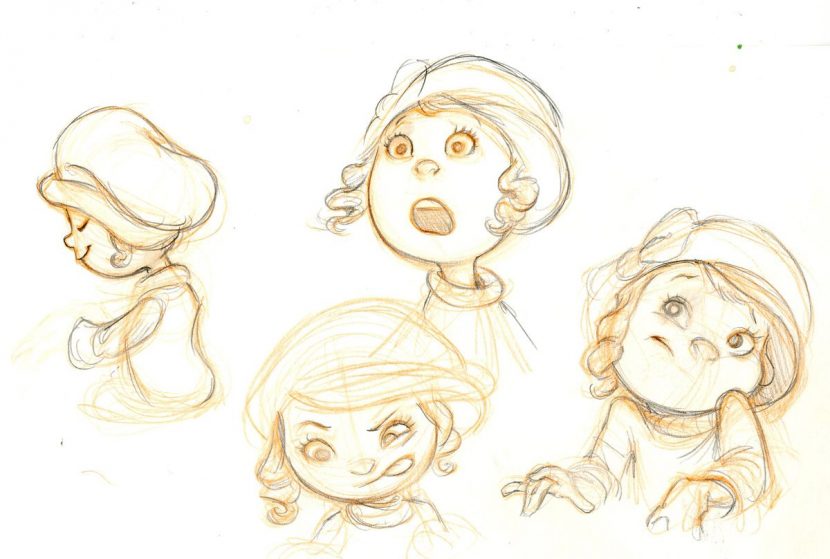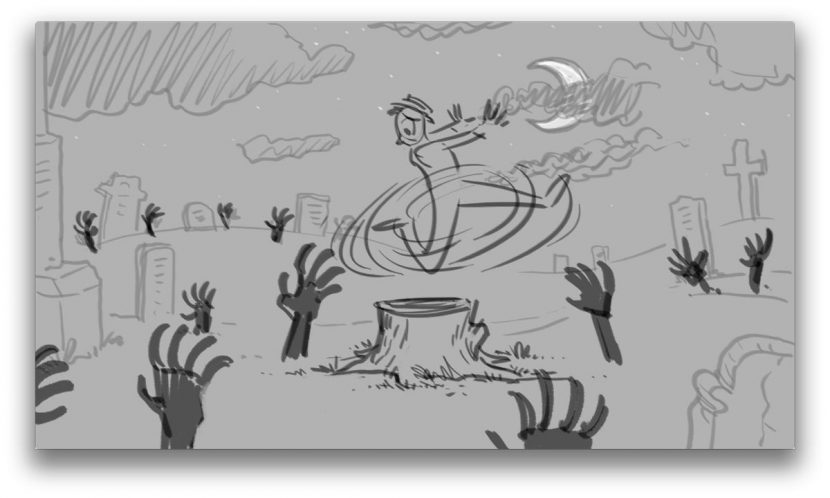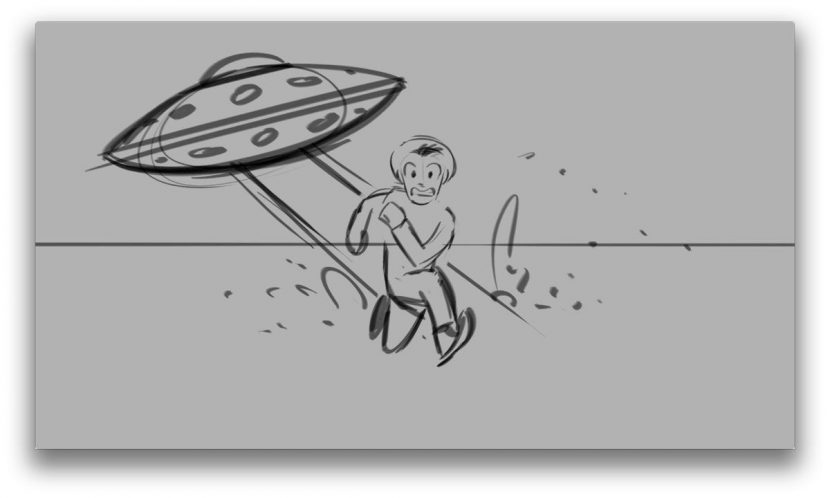When fxguide attended the SciTech Awards recently, one highlight was the debut of Dolby short film ‘Silent’. The beautiful animated film was designed to showcase Dolby’s partnership with the picture and sound industries over many decades. Below, fxguide speaks to Moonbot Studios about how they made the film and shows an EXCLUSIVE breakdown.
You’ve seen Moonbot’s work in the Oscar-winning The Fantastic Flying Books of Mr. Morris Lessmore and more recently in the fantastical Chipotle ‘Scarecrow’ spot. The film actually stars the Morris character as one-half of a struggling team of street performers who eventually discover a machine that takes them through a history of sound on film.
Silent was directed by Moonbot founder Brandon Oldenburg and creative director Limbert Fabian. Steve Boeddeker was the film’s sound editor (he is nominated for an Oscar this year for the sound editing of All Is Lost). John Hunter created the music.
The film was mixed in Dolby Atmos and realized also with Dolby Vision. It’s also one of Dolby’s first 4K films. A Dolby rep told fxguide: “We wanted to remind audiences that even in the golden age of ‘silent movies’, an era we pay tribute to in the film, audiences always experienced movies with both picture and sound, even if that sound was provided by local musicians. We are very proud of all the ways in which Dolby continues to innovate and advance both picture and sound.”
Interview with Moonbot Studios

fxg: What were you hoping to communicate with this film, and particularly its characters?
Brandon Oldenburg (co-director): We were thrilled when CAA Marketing asked if we could bring Morris Lessmore back for a new adventure in partnership with Dolby. We liken it to how Buster Keaton or Harold Lloyd starred in multiple movies with different adventures.
It was important that Silent wasn’t just about Morris and that we’d introduced a new character that could symbolically represent Dolby. Morris represents picture and the new Kid represents sound. It was cool to have that relationship, a bond between an older male figure and a little girl. I liken it to movies such as Paper Moon, The Professional, Frankenstein, and of course, Chaplin’s The Kid.
Movie theaters and more specifically movie theater organs have played a major role in my life. In the 50’s my dad went to college in Monroe, Louisiana studying music. He was a very gifted pianist. There was a Paramount movie palace downtown, which had a magnificent organ gathering dust. My dad had always wanted to play an organ. He worked a deal with the theater manager to play music before the films. This is how my dad met the theater manager’s daughter. She went to the same school and always did her homework up in the projection booth. So, that’s how my mom and dad met. If it weren’t for that organ, my dad would have never met my mom. Thus, Silent is a particularly special story for me. I wouldn’t be here today if it weren’t for a theater organ.
fxg: In the past you have been able to combine CG animation with real photography for backgrounds – was that something you could do at all for ‘Silent’?
Meg Deane (Lead TD): We had an incredibly quick turnaround time, so there wasn’t really time to build miniatures for this production. But in the past, on productions like The Fantastic Flying Books of Mr. Morris Lessmore and Chipotle Scarecrow, we have had so much experience with miniatures. Now, we’ve learned how to make CG elements look like miniatures. We use larger scale textures so that it doesn’t feel quite actual size.

Oldenburg: On Silent, we wanted to make things look like they were miniatures so they felt like they were part of Morris’ world.
Deane: The majority of the “movie within a movie” backgrounds are matte paintings. It was a fun challenge to integrate characters with the paintings and while making sure they look good. Shadows need to look like they are going across the surfaces, etc. It’s tricky moving characters through 2D and 3D hybrid scenes. In the scene where Morris holding on to the bridge, that’s just a matte painting so we had to get the masks just right so it looks like he’s really holding on.

fxg: Sound is obviously important in all of the films you make, but can you talk specifically about how you collaborated with Dolby and Steve Boeddeker here?
Oldenburg: It was a huge honor to work with Steve. His experience in sound design for live action and animation covers the gamut and so does our short. He brought to the table skills and sounds that evoke live action, not just animation. He did a smash up job walking our ears through the history of cinema.
Mixing in Dolby Atmos is like nothing you’ve ever experienced. Being able to digitally allocate sounds to “objects” and move them in 3D space, one can precisely pinpoint and target where a sound is coming from and going to. In our last sequence, the camera dollies back through the theatre, the applause starts behind you and then starts to wrap around you like a hug. The audience literally wraps around you and surrounds you like a warm blanket. It even has a cool subtle doppler effect to it.

fxg: Was there one shot in the film that you could break down perhaps that was particularly challenging in terms of storytelling and realizing the animation?
Deane: For the technical directors, the running scene was challenging because of the number of sets Morris appears in. There are 2D backgrounds and sets, so it was a different pipeline than the rest of the film. Getting all of that to work in the same scene was a challenge.
Oldenburg: Keeping our short, “short” was the most difficult challenge while working on this story. From a storyboarding and editorial pass, we went through much iteration, lengthening some shots so it didn’t feel rushed. However, we did need to make sure the story was bite sized. We tried to put more into each shot rather than using multiple cuts. To tell a story of this depth in 2 1/2 minutes requires great restraint and openness to removing things you have fallen in love with.

fxg: What were the main tools you used for animation, rendering and compositing?
Deane: We used Maya for animation and lighting and everything really. We used Mental Ray for rendering. We used our proprietary software Butterfly for rigging, Nuke for compositing and AFX for simple particle effects.
Waterproof Studios groomed the hair. It was then simulated in-house, using Maya’s hair system and rendered in Mental Ray. Waterproof handles the girl’s hair when it comes out of her hat, because it’s really intense. They use Yeti for hair and Arnold for rendering.
In the beginning shots, all the rain was done by Waterproof, using Trapcode Particular. We used Fume FX for the explosion and train smoke. The 2D animation in the cartoon sequence was done by Powerhouse Animation Studios. In editorial, we used Hiero and Final Cut. Hiero is a new editorial software from the Foundry that we’ve found useful.

For overflow rendering we used ZYNC’s cloud render farm. Dolby asked us to create a number of billboards that you can see in L.A. near the Dolby Theatre and all of the rendering for those was completed using ZYNC. Some other tools we use are Perforce for file management and Shotgun for task tracking.
Oldenburg: We used the full gamut of Tombow’s grey scale markers for storyboarding. Lots of excel spreadsheets, post it notes and dry erase boards. When we had run out of paper and wall space, we wrote on the glass that separates our offices. It’s all very proprietary and high tech.

I can only imagine how it looks and sounds on a big screen, because for me, the unimaginative and unoriginal story is very… vanilla. Really underwhelming.
Pingback: Dolby’s short film ‘Silent’ | ila.solomon